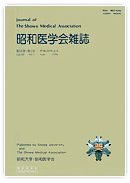All issues

Successor
Volume 69 (2009)
- Issue 6 Pages 455-
- Issue 5 Pages 387-
- Issue 4 Pages 297-
- Issue 3 Pages 211-
- Issue 2 Pages 109-
- Issue 1 Pages 1-
Volume 69, Issue 6
Displaying 1-6 of 6 articles from this issue
- |<
- <
- 1
- >
- >|
Final Lecture
-
[in Japanese]2009 Volume 69 Issue 6 Pages 455-466
Published: December 28, 2009
Released on J-STAGE: May 20, 2011
JOURNAL FREE ACCESSDownload PDF (1956K) -
[in Japanese]2009 Volume 69 Issue 6 Pages 467-480
Published: December 28, 2009
Released on J-STAGE: May 20, 2011
JOURNAL FREE ACCESSDownload PDF (413K)
Original
-
—Report from a 16-year epidemiological survey at a university hospital—Nobuhiro SATO, Koichi KADOMATSU, Yoshiaki HOSAKA2009 Volume 69 Issue 6 Pages 481-489
Published: December 28, 2009
Released on J-STAGE: May 20, 2011
JOURNAL FREE ACCESSThree hundred zygomatic bone fracture cases involving infraorbital neuropathy treated at our hospital were investigated in detail. In comparison with past literature, the morbidity ratio of Knight & North classification, the sex ratio, the laterality and the operation ratio were the same. We divided the zygomatic bone fracture types into two groups classified by fracture line intersecting infraorbital foramen, an intersecting group A and a non-intersecting group B; it became clear that both groups showed no significant difference (47.7% vs 52.3% P = 0.453 Fisher's exact test). Infraorbital neuropathy incidence ratio was calculated and group A was significantly different (74.1% vs 38.9% P = 0.000 Fisher's exact test). Furthermore, the infraorbital neuropathy improvement ratio was calculated and did not show a significant difference between groups A and B (68.9% vs 70.5% P = 0.826 Fisher's exact test). The incidence ratio of infraorbital neuropathy, especially that of group B (38.9%), indicate the need for further study concerning an inspection and operative plan for the zygomatic region.View full abstractDownload PDF (619K) -
Ryou MORITA Ryou MORITA, Yusaku MORI Yusaku MORI, Soushou LEE Soushou ...2009 Volume 69 Issue 6 Pages 490-498
Published: December 28, 2009
Released on J-STAGE: May 20, 2011
JOURNAL FREE ACCESSPrevious studies have reported that statins suppress the progression of chronic kidney disease (CKD). The effects are independent of lowering serum cholesterol and could be different for each statin. Statins do not change serum cholesterol levels in rats. We administered pitavastatin into a CKD rat model to confirm the renoprotective effect of pitavastatin without lowering cholesterol. We prepared the CKD rat by removing 2/3 of the left kidney and the whole right kidney, and randomly dividing the kidney into the pitavastatin treatment group (n = 7) or the no treatment group (n = 7). Pitavastatin was administered by gavages at 3mg/kg/day for 12 weeks. At the end of the experiment a remnant of the kidney was removed to evaluate pathological changes and quantitative real-time PCR (qPCR). There were no differences in diet intake, body weight, and serum lipid profiles between the two groups. However, pitavastatin treatment diminished serum creatinin elevation (1.1 ± 0.8 vs. 1.9 ± 0.7mg/dl) and creatinin-clearance depletion (23 ± 7 vs. 13 ± 4ml/min/g). The pitavastatin group showed suppression for urine protein (175 ± 45 vs. 273 ± 35mg/ml·Cre) and albumin (968 ± 95 vs. 1483 ± 214μg/ml·Cre). Microscope pitavastatin treatment ameliorated the glomerular sclerosis index score (2.5 ± 0.4 vs. 3.2 ± 0.4) and interstitial fibrosis score (24.3 ± 3.8 vs. 34.8 ± 5.8) in the remnant kidney. By qPCR the expression of TGF-β and CTGF mRNA were suppressed by pitavastatin. The pathological changes were significantly correlated with serum creatinin, creatinin-clearance, urine protein, urine albumin, and the mRNA expression of TGF-β and CTGF. We confirmed that pitavastatin had a renoprotective effect without changing serum lipid profiles. The changes may be induced by the suppression of TGF-β and CTGF through the pleiotrolic effect of pitavastain.View full abstractDownload PDF (798K)
Case Reports
-
Hiroyuki KIDA, Yoshio DEGUCHI, Hisasi KASUGAI, Jyunnichi TANAKA, Shinn ...2009 Volume 69 Issue 6 Pages 499-505
Published: December 28, 2009
Released on J-STAGE: May 20, 2011
JOURNAL FREE ACCESSThis reports a 71-year-old man whose chief complaiant was a feeling of fullness in the abdomen. CT scan showed the right kidney was displaced from the right dorsal side, and a huge tumor occupied the right peritoneal cavity. Fat concentration was significantly higher among the various densities observed in the interior of the tumor and the right kidney was buried in the tumor. Retroperitoneal liposarcoma was diagnosed, and retroperitoneal tumorectomy and partial resection of the right adrenal gland together with the right kidney were carried out. The resected specimens weighed 7.9 kg. Histopathological diagnosis was myxoid liposarcoma. As the effect of radiation therapy and chemotherapy on liposarcoma has received little evaluation, a follow-up is under way without adjuvant treatments.View full abstractDownload PDF (721K) -
Toshitugu KATO, Kaneshige SATO, Yoshiaki HOSAKA2009 Volume 69 Issue 6 Pages 506-511
Published: December 28, 2009
Released on J-STAGE: May 20, 2011
JOURNAL FREE ACCESSIt is known that in sagittal syonstosis the cranial morphology generally becomes scaphocephaly or acrocephaly. We had the opportunity to treat a case of sagittal synostosis with brachycephaly and "deformity like saddle" in an 11-month-old boy. Findings of synostosis in the posterior third of the sagittal sutures were observed from X-ray images. Considering the possibility of symptoms due to intracranial hypertension developing in the future, cranioplasty was planned and the operation was performed. Now at 4 months after surgery, good cranial morphology is maintained and symptoms due to intracranial hypertension have not been seen. We report the variety of cranial deformities in sagittal synostosis with bibliographical consideration.View full abstractDownload PDF (560K)
- |<
- <
- 1
- >
- >|